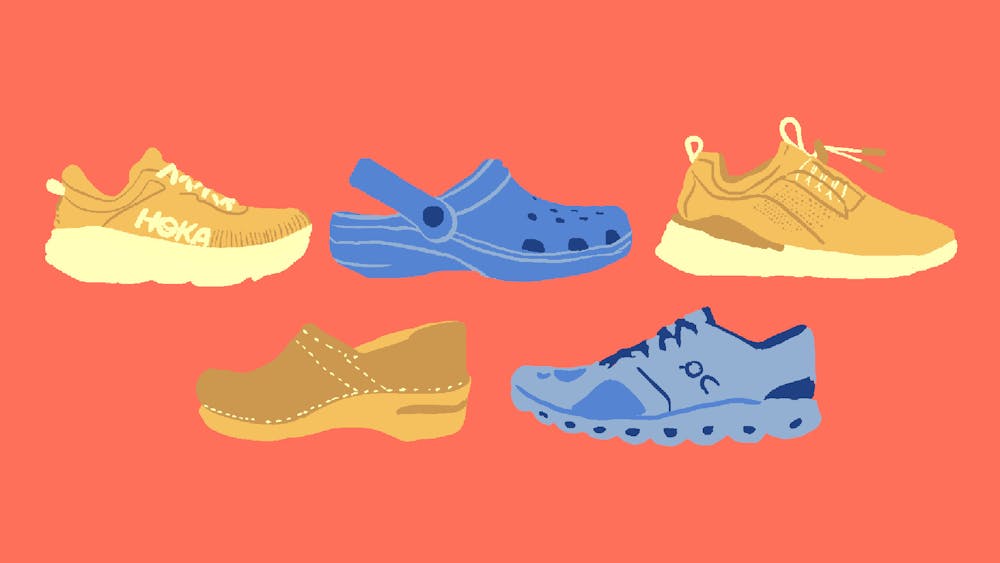In the nursing community, the shoes a nurse wears have grown to be more defining than which outlandishly long shifts they’re scheduled to work week-to-week. Are you the Hoka–wearing, Stanley–cup–sipping bubbly day shift nurse? Or are you the baggy scrubs, Dansko–wearing, Monster drinking night shift intensive care unit nurse? Maybe you are the Clove–wearing, TikTok addicted new orientee on the med–surg floor? Nurses are constantly standing, lifting, and running throughout their shifts. They have strong opinions about safe nurse–to–patient ratios and healthcare reform, but even stronger opinions about what shoes will carry them through their shift.
Oftentimes, nurses spend slow shifts browsing the next “hot” shoe to sport and arguing with their coworkers about what shoe is top dog. The uniform is the same across the nursing field: scrubs. But, their choices of footwear are where they diverge.
The first shoes nurses wore were, probably, no shoes at all. In the 1300s, the first nurses were nuns. During the Crimean War, Florence Nightingale, the mother of modern nursing, was a champion for nurse and patient rights—she believed that what nurses wore directly correlated to how they represented the profession. In Nightingale's time, most nurses wore black, leather lace–up shoes with a slight heel. These shoes were durable, comfortable, and practical for some of the most grueling years in nursing history.
Throughout the early 1900s, shoe companies began advertising directly to nurses, boasting why their shoes made the perfect fit (true to size and function). At this moment, there was a shift from black shoes to white shoes. White shoes began to symbolize pureness and cleanliness in the nursing profession, deeply rooted in its Catholic origins.
Centuries later, the power of the white shoe still impacts the field of nursing. Many nursing programs require students to wear canvas, all–white, washable shoes to ensure they will stay perfectly clean. The trend of white shoes and all–white uniforms remained in the nursing world throughout the 20th century and made its way into popular media—think less glamorous and far more modest versions of the classic “sexy nurse” Halloween costume.
By the 1980s, nursing uniforms became more unisex and less … white. Feminist thinkers claimed that the all–white uniforms symbolized diminished a nurse’s sense of power and autonomy. In the 1990s, clogs became the main shoe seen on the floor. To this day, some nurses still swear by clogs, and others opt for athletic sneakers or Crocs packed with Jibbitz.
If you were to search ”nursing shoes” on TikTok, there are thousands of videos of nurses comparing and contrasting footwear makes and models. In a February 2024 video, TikTok user and ICU nurse @nurse_ekm determines what the shoes you wear to work say about you. She describes the aura of Dansko nurses after years of observation: “You’re a device diva/CVICU nurse. You came to work in surgical scrubs without ever stepping inside an operating room (OR). Everyone is slightly afraid of you.” The video remarked on nurses who prefer wearing Hokas, On Clouds, Danskos, Birkenstocks, Nikes, Cloves, New Balances, Brooks, and Crocs. Most commenters agreed with the sentiments shared; one comment reads, "i’ve worked with all of these nurses and the accuracy is insane.”
In a recent discussion with nurses during my clinical shift, I found myself craving to buy a new pair of shoes. As a nursing student, I turn to my professional elders with years of new shoes under their belts. A nurse manager shared how she had worn Danskos for years until her daughter converted her to Hokas. She’s confident that she’ll never go back to the dark side of back and joint pain.
Another nurse chimed in, saying that she doesn’t care what shoes she wears. She only cares if they’re cheap and comfortable. I watched her retreat to her patient’s room wearing an old, reliable pair of black and pink Dr. Scholl’s sneakers.
That day, my assigned nurse had a vast and, frankly, impressive background in making footwear decisions; while nursing is his day (and night) job, he has been running marathons for years. He took off his shoe to show me his black slip–on Oofos clog up close. He doesn’t wear sneakers because he feels like the soles wear down too fast after being on your feet for hours on end. I then took off my gray (supposed to be white) Hokas and showed him in exchange. He shook his head. “Hokas are overrated,” he said. I laughed.
As a nurse is donning the shoes they are going to wear for the next twelve hours, they are empowering themselves to advocate for and assist their patients. The extensive history of the nursing uniform shows how the profession has been deeply impacted by uniform requirements. From black leather mules to printed clogs, wearing shoes that are both comfortable and stylish supports nurses' joints and fosters confidence in the care they’re providing. No matter if a nurse is team Hoka or team Clove, they should be supported at their feet so their hands can heal.

